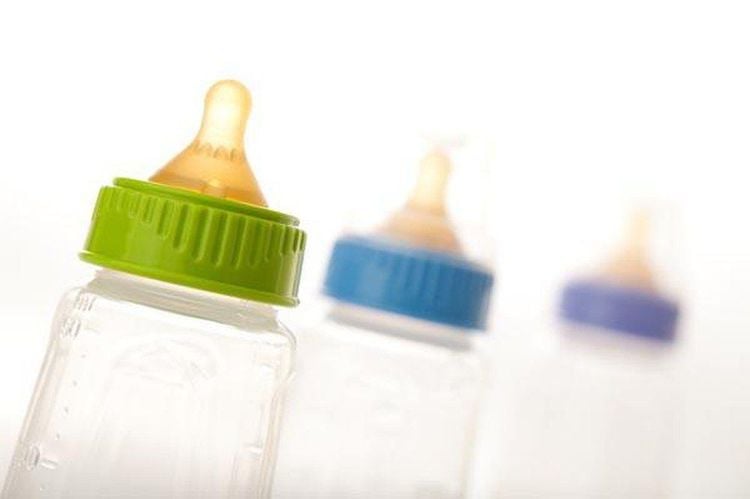This is an automatically translated article.
Not all babies accept bottle feeding from the start, don't be discouraged when your baby refuses to use the bottle. Try some of the tips below to help your baby get used to bottles.
1. What is the best way to introduce your baby to bottles?
Most lactation experts suggest that mothers should wait until the baby is 1 month old and can drink milk from the breast maturely before the mother can practice using a bottle for the baby. And after 6 months of maternity leave, mom will have to go back to work, this is also the time when you have to get used to the new regime. Mothers should give the baby bottle-feeding for 2 weeks before going to work so that both mother and baby have time to adjust the habit accordingly.
Also, remember that bottle feeding is very different from breast feeding because it is easier to get milk from a bottle. (Some babies prefer a bottle for this reason.) Do not force more than your baby seems ready to eat. Your baby's doctor can advise you on the right amount for your baby as he grows.
Bottle-feeding is like breastfeeding, so cuddle your baby close. Some babies like to be held in a nursing position when bottle-feeding, but others find it uncomfortable. Whatever position you choose, try to maintain eye contact with your baby. (And don't feed your baby while he's lying on his back as he could choke.)
Bottle feeding has a different tongue and lip movement than breast feeding, so give your baby some time to do it. Get used to the change from nipple to bottle. Try these few tips to make the process of latching easier:
Introduce your baby to the bottle after dinner to help him get used to the nipple of the bottle. Breastfeeding should be started with a small amount of breast milk – about 15ml. Use slow flow nipples. For many babies, regular pacifiers can cause them to choke on milk. If your baby coughs while drinking from a bottle, you can change her to a slow-flowing pacifier.

Sử dụng núm vú chảy chậm để giúp bé không bị ho khi bú bình sữa
Let someone else introduce your baby to the first bottle. If the mother teaches the baby on his own the first time using the bottle, the baby will stir and ask for direct feeding. But if someone else bottle-feeds your baby, your baby will be less fussy. You can ask your grandmother, father, or someone close to help you with this. Try going out of the house: Your baby can sense your breath, even if you're not around, so he can know that you and your breast milk are in the next room and they'll ask for breast milk, not a bottle. The baby may eat less when the mother is away and may wake up frequently in the middle of the night if the mother is away all day. Don't worry about it, take advantage of the moments with your baby to reconnect with him.
2. What should the mother do if the baby refuses to feed?
Many babies are very good with bottles, but many other babies are fussy. If your baby refuses to take a bottle forever, you can use a few tips below:
Use a bottle with the same nipple as your baby's nipple. If your baby can suck on a rubber pacifier, then you can choose a bottle with a nipple and vice versa. Warming the nipple of the bottle with warm water will stimulate the baby to suck more. Apply some breast milk to the nipple. When your baby tries to suck on a nipple smeared with breast milk, when he recognizes a familiar taste, he may suck more. (Do not apply honey to nipples, it can cause poisoning in babies under 12 months old.) Let your baby play with the nipple of the bottle to get used to it. If the baby just grinds the nipple, then leave it alone, because the baby will probably start sucking on it later. Hold your baby in a different position. Place your baby in an infant or car seat so he's slightly tilted, then offer the bottle while facing him. Or you can try bottle-feeding your baby while sitting on your lap, with his back turned to the person's chest. Once your baby gets used to bottle-feeding, you can often bottle-feed your baby.

Mẹ nên thường xuyên thay đổi tư thế khi cho bé ti bình
Try different temperatures. Your baby may prefer the milk to be slightly warmer or colder than what you're making for him. You can try different temperatures to see your baby's preference. Parents can see a difference when giving their baby a regular temperature bottle or slightly cold milk. Bottle-feed your baby at various times of the day. If your baby does not take a bottle during the day, you can breastfeed at night and vice versa. It takes time for babies to get used to new sensations, so you should stick to the same nipples, bottles and feeding methods for a while before trying new ones. Frequent changing of breastfeeding positions or different types of nipples makes the baby more uncomfortable and fussy.
Mom, please give your baby a lot of time to slowly get used to the bottle. When your baby starts to cry and pushes the bottle away, comfort him to make him more comfortable and then move on. If you've tried handing over the bottle but the baby pushed it away all three times, go for it. (Wait at least 5 minutes before feeding, this will prevent your baby from thinking that if you give up the bottle, you will get breast milk.)
About an hour or two later, when the baby is awake and easier to eat But if you're not too hungry, try giving your baby a bottle to keep practicing.
Success in the first few sessions is not a guarantee that your baby will be good in subsequent feedings. Many babies are very good at bottle-feeding, but soon they will realize that they only love the breast and won't want to bottle-feed again. Because when the mother's breast is very warm, comfortable, and also from the person that the baby loves very much - Mom. But don't worry: for most babies this is just a stepping stone to practice. If your baby suddenly refuses to breastfeed, talk to your baby's doctor to find out if there is a reason for your baby's health and then give him another time to practice.
In some countries, abandoned babies have been taught to drink milk from a cup since birth. This method has several advantages: your baby won't be upset when he has to practice with the nipple of the bottle, you won't need to introduce your baby to midday or midnight (this can lead to worms). tooth ). I also won't have to change your child's pacifying habits.

Mẹ cần kiên trì và dành nhiều thời gian để tập cho bé làm quen với cảm giác mới
Of course, teaching your baby to drink from a cup takes a lot of time. If you don't use a practice cup or a cup with a straw, you'll have to help your baby learn to drink and be prepared to deal with potential messy situations.
Tips to help your baby get used to the bottle can also be applied in learning to drink from a cup. Introduce your baby to drinking from a cup early (but only after he's mastered breastfeeding) and get used to it gradually by using a feeding cup once a day. Before you go back to work, spend a few weeks training your baby, helping him get used to new habits.
Whatever your reason for not breastfeeding, give yourself time to rest. Formula feeding is an affordable and healthy choice for babies. Formula even has some nutrients that breastfed babies must get from supplements, like vitamin D.
If this happens, it's not entirely mom's fault, so don't blame yourself: "If only she had introduced her to once a day in the first place, this wouldn't have happened." The truth is not so. There are some children who never give up.
If all attempts to get your baby to bottle-feed fail, then you can switch to trying with a sippy cup. Hold your baby upright with one hand, place the cup by her mouth, and then tilt it slightly to let breast milk or formula drip into her mouth. Your baby will reach for the cup and find a way to continue drinking. You can use a spoon to give your baby medicine to replace the cup, but in the same way.
In the process of training to switch from breastfeeding to bottle feeding, there are babies who refuse to take bottles right away, parents should be consulted by a pediatrician to have the most suitable way for their baby.

Cha mẹ có thể tham khảo ý kiến bác sĩ để tìm ra phương án phù hợp nhất với bé
As a key area of Vinmec Health system, Pediatrics Department always brings satisfaction to customers and is highly appreciated by industry experts with:
Gathering a team of top doctors and nurses in Pediatrics : consists of leading experts with high professional qualifications (professors, associate professors, doctorates, masters), experienced, worked at major hospitals such as Bach Mai, 108.. Doctors All doctors are well-trained, professional, conscientious, knowledgeable about young psychology. In addition to domestic pediatric specialists, the Department of Pediatrics also has the participation of foreign experts (Japan, Singapore, Australia, USA) who are always pioneers in applying the latest and most effective treatment regimens. . Comprehensive services: In the field of Pediatrics, Vinmec provides a series of continuous medical examination and treatment services from Newborn to Pediatric and Vaccine,... according to international standards to help parents take care of their baby's health from birth to childhood. Advanced techniques: Vinmec has successfully deployed many specialized techniques to make the treatment of difficult diseases in pediatrics more effective: neurosurgery - skull, stem cell transplant blood in cancer treatment. Professional care: In addition to understanding children's psychology, Vinmec also pays special attention to the children's play space, helping them to play comfortably and get used to the hospital's environment, cooperate in treatment, improve the efficiency of medical treatment. In addition to the above advantages, Vinmec is now equipped with many modern medical equipment, standard medical machinery system, sterile space, avoiding infection, ensuring the safety of children during the procedure. medical examination and treatment. Parents can rest assured when using medical services at Vinmec.
If you have a need for consultation and examination at Vinmec Hospitals under the nationwide health system, please book an appointment on the website for service.
If there is a need for consultation and examination with experienced pediatricians at Vinmec. Please make an appointment at the website to be served.
Please dial HOTLINE for more information or register for an appointment HERE. Download MyVinmec app to make appointments faster and to manage your bookings easily.
Reference source: babycenter.com












